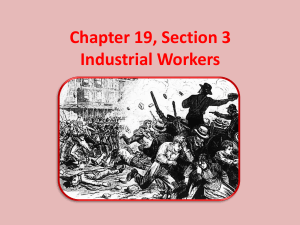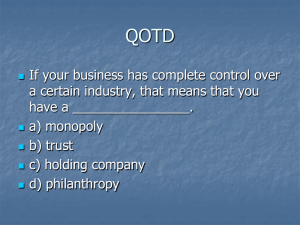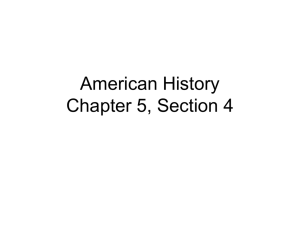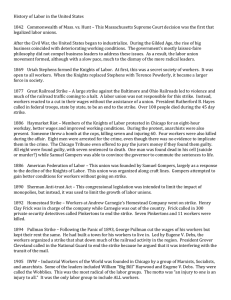Organized Labor Movement
advertisement
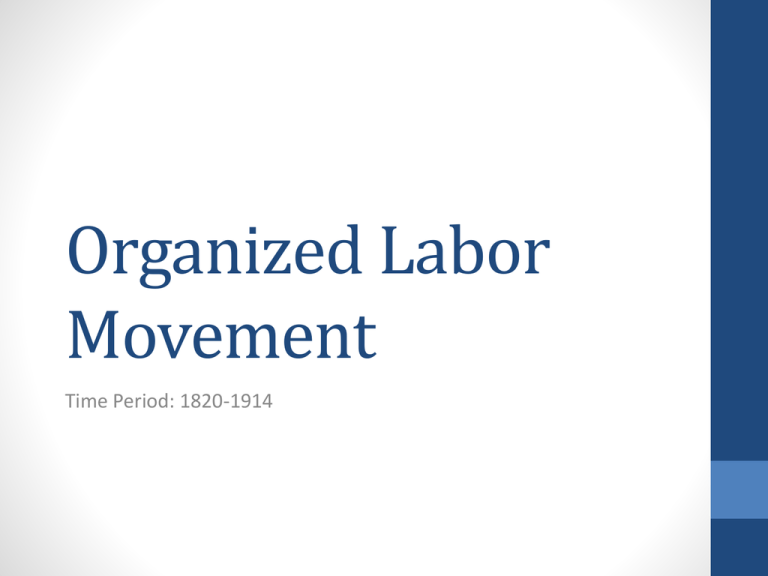
Organized Labor Movement Time Period: 1820-1914 Essential Question: • How did the rise of labor unions shape relations among workers, big business, and government? Terms and People: • AFL • Collective bargaining • Company town • Eugene V. Debs • Haymarket Riot • Homestead Strike • Knights of Labor • Pullman Strike • Sweatshop • Samuel Gompers • Socialism • Terence v. Powderly Typical Day in a Factory • 12 hour days • 6 days per week • Small, hot, dark and dirty sweatshops • Owners ensured productivity by strictly regulating hours – lunches, breaks • Workers paid fines for breaking rules or working too slowly • Noisy machines – workers lost hearing • Faulty equipment/lack of training = tons of accidents Child Labor • Workers were paid very little; parents brought children to work to keep them off the streets and to earn a small wage. • Late 1800s - one in five children between 10 and 16 worked in a factory rather than attending school! • 1890s – Social Workers push to get children out of factories; states begin passing child labor laws. Company Towns • • • • Business owner rents houses to laborers. Laborers forced to shop at company owned store. Sold on credit; high interest! Forced into wage slavery HC Frick Coke Company Town, Shoaf, PA Think about it… • What were working conditions like? • How did working conditions affect families? Early Labor Protests • Collective Bargaining – Negotiating as a group for higher wages or better working conditions. • First national labor union was founded in 1834 – National Trades Union, open to workers from all trades. Only lasted a few years. • Successfully negotiated slightly shorter work days in New England – 10 hour workday became standard. What is Socialism? • Economic and political philosophy that favors public, instead of private, control of property and income. Wealth should be distributed equally to everyone. • This idea spread through Europe in the 1830s. • Karl Marx and Friedrich Engels, Communist Manifesto, denounced capitalism and predicted workers would overturn it. Knights of Labor (1869) • • • • • Founded by Uriah Smith Included workers from all trades Actively recruited African Americans Secret society devoted to broad social change Sought to replace capitalism with workers cooperatives Uriah Smith Stephens Knights of Labor Seal The Knight’s Constitution “The recent alarming development and aggression of aggregated wealth, which, unless checked, will inevitably lead to the pauperization and hopeless degradation of the toiling masses, render it imperative, if we desire to enjoy the blessings of life, that a check should be placed upon its power…and a system adopted which will secure to the laborer the fruits of his toil.” -Preamble to Knight’s Constitution, 1878 Knights of Labor Expands… • Began leading the Knights of Labor in 1881. • Moved the secretive Knights of Labor into the mainstream; focused on wide social change. • By 1885, Membership grew to over 700,000 men and women nationwide. • Organization died out during the 1890s due to several failed strikes. Terence V. Powderly American Federation of Labor • Formed by Samuel Gompers in 1886. • Focused on specific workers’ issues: wages, working hours and conditions. • Charged high membership fees and created a strike and pension fund for workers in need. • Opposed women members because Gompers thought their presence in workplace would drive wages down • African Americans were usually excluded. Samuel Gompers, 1902 Think About It… How were these two labor unions different? Major Strikes of the Late 1800s Strike Cause Effect Railroad Strike, 1877 Response to cuts in workers’ wages Set the scene for violent strikes to come Haymarket Square, 1886 Part of a campaign to achieve an eight-hour workday Americans became wary of labor unions; the Knights of Labor were blamed for the riot and membership declined Homestead Strike, 1892 Economic depression led to cuts in steelworkers’ wages After losing the standoff, steelworker unions lost power throughout the country Pullman Strike, 1893 Wages cut without a decrease in the cost of living in the company town Employers used the courts to limit the influence of unions Eugene V. Debs • The son of poor immigrants, eventually worked his way up to become the head of the American Railway Union. • Imprisoned for his role in the Pullman Strike; read the works of Karl Marx and eventually became a socialist. • Ran for President five times between 1900 and 1920 on the Socialist Party ticket. • Pacifist who opposed US participation in World War I. • Imprisoned for opposing the government; received one million votes in the 1920 election while in prison! Eugene V. Debs Effects of the Labor Movement • Employers appealed frequently for court orders against unions and the government approved the appeals; denying unions recognition as legally protected organizations. • Government severely limited union power for 30+ years. • Industrialists, workers and government agencies battled over labor issues during the start of the 20th century. • Strikes, contract negotiations, and legislation very common. • Debs – Socialist Party – Industrial Workers of the World (IWW) – Violent protests – What until you see what happens next… Free Write: • In your notebooks (I will look for it during the Notebook check!!), please write two concise paragraphs discussing the relationship between the following terms: • • • • • • • • • • • • AFL Collective bargaining Company town Eugene V. Debs Haymarket Riot Homestead Strike Knights of Labor Pullman Strike Sweatshop Samuel Gompers Socialism Terence v. Powderly Try to use at least 8 of the terms! Circle the key terms!!
